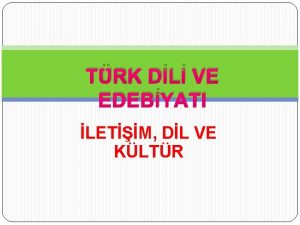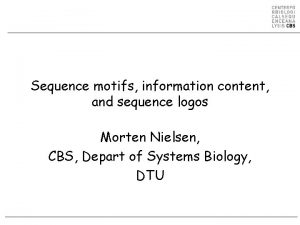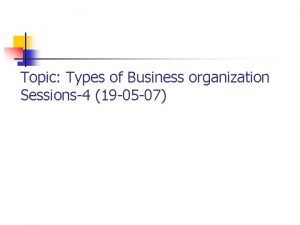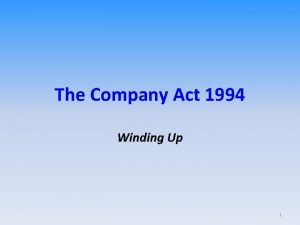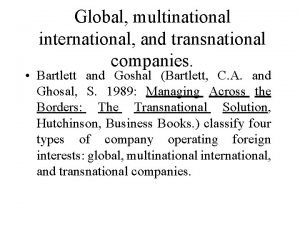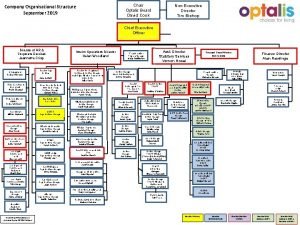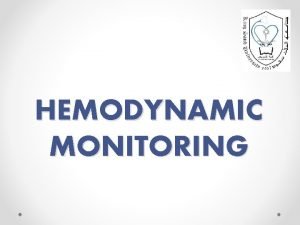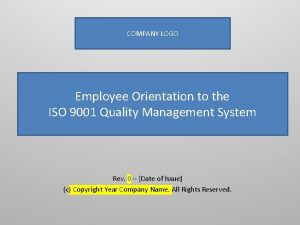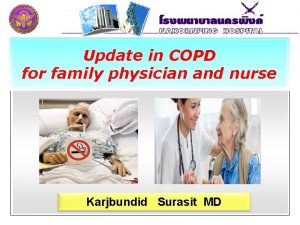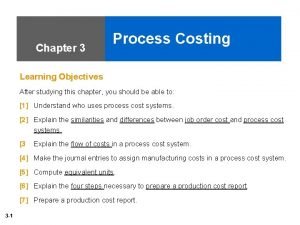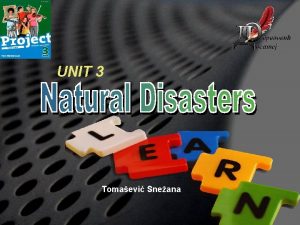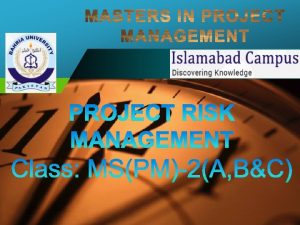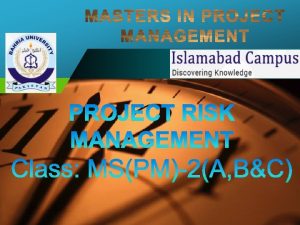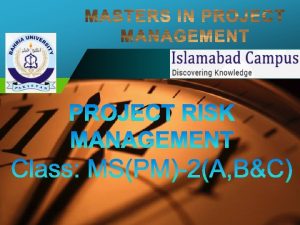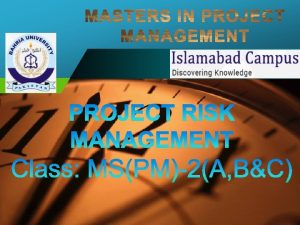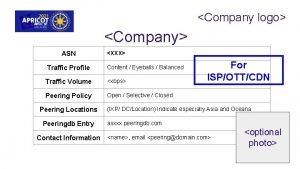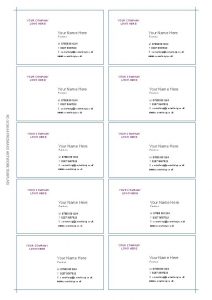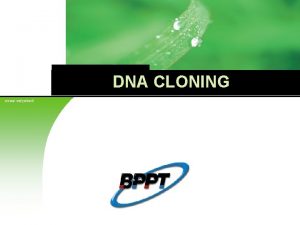Company LOGO Company LOGO oner Unit Content 4











































- Slides: 43

Company LOGO

Company LOGO oner.

Unit Content • • 4. Principles & Concepts • • • Definition of Project Risk Individual Risks and Overall Project Risk The Natural Project Risk Management Sequence Risk Management – An Integrative Function Stakeholder Risk Attitudes Variations of Risk Factors Through the Project Life Cycle Four-Phase Approach Iterative Process Communication Responsibility for Project Risk Management Project Manager’s Role for Project Risk Management Learning Objectives Understand various principles and concepts involved in Project Risk Management specifically indicating various roles and responsibilities of Stakeholders and Project Manager

UNIT 4 PRINCIPLES AND CONCEPTS

UNIT 4 Understand various principles and concepts involved in Project Risk Management specifically indicating various roles and responsibilities of Stakeholders and Project Manager

UNIT 4 • • • Definition of Project Risk Individual Risks and Overall Project Risk The Natural Project Risk Management Sequence Risk Management – An Integrative Function Stakeholder Risk Attitudes Variations of Risk Factors Through the Project Life Cycle Four-Phase Approach Iterative Process Communication Responsibility for Project Risk Management Project Manager’s Role for Project Risk Management

UNIT 4 “Project Risk is an uncertain event or condition that, if it occurs, has a positive or negative effect on the From A Guide to Project Management Body of project objectives. ” Knowledge (PMBOK®), 4 Ed, PMI “Project Risk is the cumulative effect of the chances of uncertain occurrences adversely affecting From Project and Program Risk project objectives. ” Management, Max Wideman, PMI th Project objectives include: • Scope • Schedule • Cost • Quality

UNIT 4 Uncertainty – Probability or Likelihood • Clearly described • Less specific Effect – Impact or Consequence • Negative Effect – Threats may be called Issues or Problems • Positive Effect - Opportunities may be called Benefits From A Guide to Project Management Body of Knowledge (PMBOK®), 4 th Ed, PMI

UNIT 4 Cause – Events or circumstances which currently exist or are certain to exist in the future and which might give rise to risks. Effect – Conditional future events or conditions which would directly affect one or more project objectives if the associated risk occurs. Cause-Risk-Effect Chain can be used in a structured risk statement or risk description to ensure that each of these three elements is properly described. From Practice Standard for Project Risk Management, 1 st Ed, PMI

UNIT 4 • When Risk Event occurs, it ceases to become Uncertain • Both Issues/Problems or Benefits entail project management actions that are outside the scope of Project Risk Management process. From Practice Standard for Project Risk Management, 1 st Ed, PMI

UNIT 4 Individual Risks • Specific Events or conditions that might affect project objectives Overall Project Risk • Effect of uncertainty on the project as a whole. • More than the sum of individual risks on a project. • Represents exposure of stakeholders to the implications of variations in project outcome. From Practice Standard for Project Risk Management, 1 st Ed, PMI

UNIT 4 • Important component of strategic decision making, program management, portfolio management, and project governance where investment are sanctioned or cancelled and priorities are set. • • Necessary to set realistic targets for the cost and duration of a project. Establishing the contingency reserve levels required to protect the project stakeholders. Set appropriate project priorities. Judge whether the risk of overall success is increasing or decreasing as implementation advances. From Practice Standard for Project Risk Management, 1 st Ed, PMI

UNIT 4 Poor Performance on Projects is attributed to: • Unforeseen Events – which might or might not have been anticipated by more experienced project management. • Foreseen Events – for which risks have not been fully accommodated. Management’s Attitude to Risk itself • Some have little understanding of the concepts • Others lack confidence in mathematical techniques and results obtained preferring to • aggressive risk taking or • undue caution • Inherent risks may simply be optimistically ignored. From Project and Program Risk Management, Max Wideman, PMI

UNIT 4 Concept Phase • Greatest degree of uncertainty • Change is an inevitable part of the iterative nature of managing projects • Yet its extent and effects are often underestimated at this time • Need for a process for the realistic appraisal of factors affecting the accomplishment phases of the project is essential. From Project and Program Risk Management, Max Wideman, PMI

UNIT 4 Formal Process • Risks are systematically identified, assessed and provided for. • Involves deliberate sequence of identification, followed by mitigation. • Mitigation calls for assessment and response. • Defensive actions – Risk Avoidance or Deflection • Risk Assessment – detailed impact analysis, response planning and contingency planning • Alternative workarounds. • Budgeted contingency allowance From Project and Program Risk Management, Max Wideman, PMI

UNIT 4 Formal Process • Uncertainties are numerous and interrelated • Affects project results in complex ways. • Tends to lead to under-estimation of risk • Difficulty in identifying and prioritizing the areas to focus for Risk Management • A systematic approach is required to: • Sort through myriad of uncertainties • Pin point the truly critical ones • Identify effective ways of reducing those uncertainties, consistent with overall project objectives. From Project and Program Risk Management, Max Wideman, PMI

UNIT 4 • Failure to give proper recognition to risk management can lead to unnecessary and often substantial losses, or even complete project failure. • Status of risk on a project varies significantly during the course of its life cycle. • Most effective time for achieving the greatest impact on project results is early on in the project development phase. • Risk management should be established as a continuing integrative function throughout the project’s life cycle. From Project and Program Risk Management, Max Wideman, PMI

UNIT 4 From Project and Program Risk Management, Max Wideman, PMI

UNIT 4 From Project and Program Risk Management, Max Wideman, PMI

UNIT 4 From Project and Program Risk Management, Max Wideman, PMI

UNIT 4 From Project and Program Risk Management, Max Wideman, PMI

UNIT 4 From Project and Program Risk Management, Max Wideman, PMI

UNIT 4 From Project and Program Risk Management, Max Wideman, PMI

UNIT 4 From Project and Program Risk Management, Max Wideman, PMI

UNIT 4 From Project and Program Risk Management, Max Wideman, PMI

UNIT 4 From Project and Program Risk Management, Max Wideman, PMI

UNIT 4 From Project and Program Risk Management, Max Wideman, PMI

UNIT 4 • Extent to which an individual risk or overall project risk matters. • A wide range of factors influence risk attitude. • Scale of the project within the range of stakeholders’ overall activities. • Strength of public commitment made about the performance of the project. • Stakeholders’ sensitivity to issues like: • Environmental impacts • Industrial relations From Practice Standard for Project Risk Management, 1 st Ed, PMI

UNIT 4 • • Usually result in a desire for increased certainty in project outcomes. May express a preference for one project objective over another. Strongly influenced by organizational culture. Depends how open an organization is. Risk attitudes must be identified and managed proactively and deliberately throughout the project Risk Management process. May differ from project to project for the same stakeholder. International, cross-industry, or multi-organizational teams. From Practice Standard for Project Risk Management, 1 st Ed, PMI

UNIT 4 • Project Risk Factors are also subject to considerable change during Project Life Cycle. • Four generic phases of a typical Project • Concept Project Planning • Development- Project Planning • Implementation-Realization/Accomplishment • Termination. Realization/Accomplishment • Opportunity and Risk remain high during Project Planning • Amount at stake remains low during Planning. From Project and Program Risk Management, Max Wideman, PMI

UNIT 4 • Four Process Phases • Identification • Assessment • Response • Documentation From Project and Program Risk Management, Max Wideman, PMI

UNIT 4 • Circumstances change as projects are being planned and executed. • Amount of information available about risk usually increase as time goes on. • Some risk will occur while others will not. • New risks will arise or be discovered. • Characteristics of those already identified may change. Project Risk Management processes should be repeated and the corresponding plans progressively elaborated throughout the lifetime of the project. From Practice Standard for Project Risk Management, 1 st Ed, PMI

UNIT 4 • The identification and analysis of risks should be revisited periodically. • The progress on risk response actions should be monitored. • Action Plans should be accordingly adjusted. • It may also be necessary to revisit the Risk Management Planning Process. • Developing an initial risk management plan and risk assessment is the start of the process, not the end. From Practice Standard for Project Risk Management, 1 st Ed, PMI

UNIT 4 • The frequency and depth of reviews and updates will depend on • The nature of the project. • The volatility of the environment in which the project is being implemented. • The timing of other project management reviews and updates. From Practice Standard for Project Risk Management, 1 st Ed, PMI

UNIT 4 • Cannot take place in isolation. • Success relies heavily on communication throughout the process. • Comprehensive input from stakeholders to ensure: • Nothing significant is overlooked • Risks are realistically assessed • Credibility of the process and Commitment of those who manage risks can only be ensured by: • The way the process operates • Conclusions it produces From Practice Standard for Project Risk Management, 1 st Ed, PMI

UNIT 4 • Effective and honest communication with • The rest of the project team • Other project stakeholders • Communications of results must meet specific stakeholders needs and expectations reflected in project communication strategy. • Role and Responsibility of each stakeholder must be identified and agreed-upon. From Practice Standard for Project Risk Management, 1 st Ed, PMI

UNIT 4 • • Risk Management is Everyone’s Responsibility Management of risks should not be left to few risk specialists. Project Risk Management – An integral part of all other project processes. Each project risk can affect project objectives. Specific roles depend upon the stakeholder placing and relationship to project objectives. Roles and Responsibilities of Project risk must be clearly defined and communicated. Individuals should be held responsible and accountable for results. Risk Related lessons are captured for future use. From Practice Standard for Project Risk Management, 1 st Ed, PMI

UNIT 4 • Encouraging senior management support for Project Risk Management activities. • Determining the acceptable levels of risk for the project in consultation with stakeholders. • Developing and approving the risk management plan. • Promoting the Project Risk Management process for the project. • Facilitating open and honest communication about risk within the project team and with management and other stakeholders. From Practice Standard for Project Risk Management, 1 st Ed, PMI

UNIT 4 • Participating in all aspects of the Project Risk Management process. • Approving risk responses and associated actions prior to implementation. • Applying project contingency funds to deal with identified risks that occur during the project. • Overseeing risk management by subcontractors and suppliers. • Regularly reporting risk status to key stakeholders, with recommendations for appropriate strategic decisions and actions to maintain acceptable risk exposure. st From Practice Standard for Project Risk Management, 1 Ed, PMI

UNIT 4 • Escalating identified risks to senior management where appropriate • Outside the authority and control of project manager • Requiring input/action from outside of project • Release of management funds might be appropriate. • Monitoring the efficiency and effectiveness of the Project Risk Management process. • Auditing risk responses for their effectiveness and documenting lessons learned. From Practice Standard for Project Risk Management, 1 st Ed, PMI

UNIT 4

The End THE END THANK YOU

 Agılda oglak togsa arıkda otı öner
Agılda oglak togsa arıkda otı öner Carrier content and real content in esp
Carrier content and real content in esp Dynamic content vs static content
Dynamic content vs static content Unit 6 review questions
Unit 6 review questions Company profile table of content
Company profile table of content Sequence logo information content
Sequence logo information content Limited company vs partnership
Limited company vs partnership Members voluntary winding up
Members voluntary winding up Capital reserve meaning
Capital reserve meaning Multinational vs international company
Multinational vs international company What type of company was the virginia company?
What type of company was the virginia company? Company logo
Company logo Company logo
Company logo Lurvin munisami
Lurvin munisami Company logo
Company logo Company name logo tagline
Company name logo tagline Logo of french east india company
Logo of french east india company Company logo
Company logo Iso company logo
Iso company logo Company logo transfers
Company logo transfers Oman drydock company logo
Oman drydock company logo Company logo
Company logo Unit 2 logo
Unit 2 logo Logo
Logo Company logo
Company logo Company logo
Company logo Insert logo here
Insert logo here Abc company logo
Abc company logo Unit 3 company structure
Unit 3 company structure Company structure unit 3
Company structure unit 3 Objective of process costing
Objective of process costing Unit 3 logo
Unit 3 logo Unit surplus dan unit defisit
Unit surplus dan unit defisit Hyp opp adj triangle
Hyp opp adj triangle Si vs english units
Si vs english units Algebra 2 unit 1 test
Algebra 2 unit 1 test Unit cost rekam medis
Unit cost rekam medis Unit process and unit operation
Unit process and unit operation Difference between unit process and unit operation
Difference between unit process and unit operation Setiap unit akuntansi dianggap sebagai unit yang mandiri
Setiap unit akuntansi dianggap sebagai unit yang mandiri Language objective
Language objective Etymology
Etymology Open word class
Open word class What are content buckets
What are content buckets
